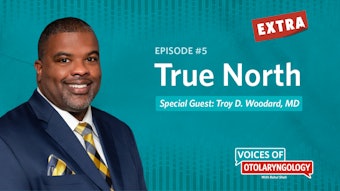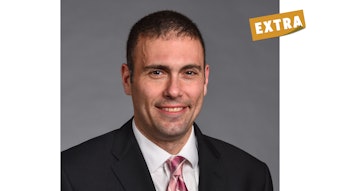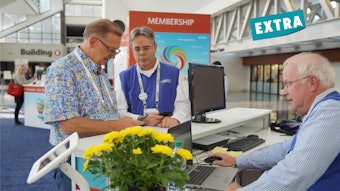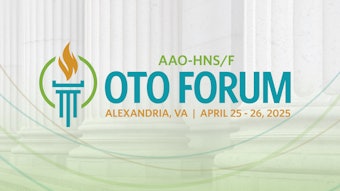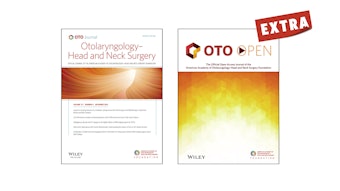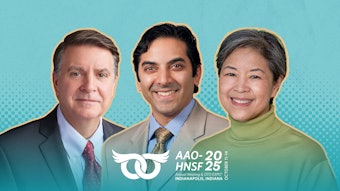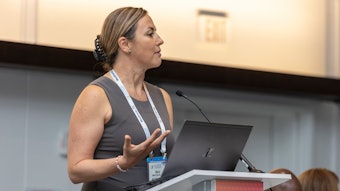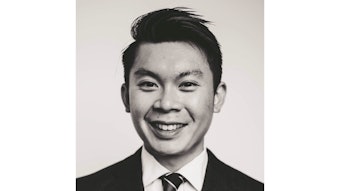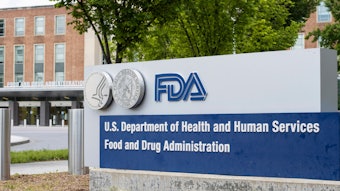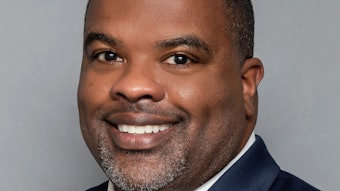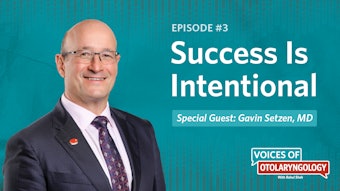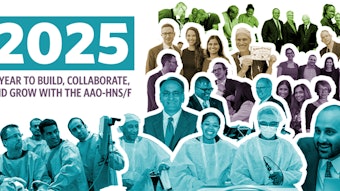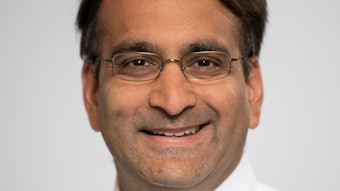Otolaryngology in World War Two
This turbulent time in world history brought major changes to otolaryngology, revolutionizing many of the most important aspects of the specialty today.
Walter M. Jongbloed, MD, and Todd Falcone, MD
This historical review was presented at the History & Archives Abstract Competition on September 30, 2024, during the AAO-HNSF Annual Meeting & OTO EXPO in Miami Beach, Florida.
Over the millennia, warfare has significantly influenced surgical disciplines. World War II profoundly affected otolaryngology in three domains. First, the recognition of noise-induced hearing loss among military personnel led to the establishment of aural rehabilitation centers, fundamentally altering the approach to hearing loss diagnosis and treatment. The treatment of major facial burns drove innovations in facial plastic and reconstructive surgery. Finally, the widespread availability of antibiotics greatly impacted the field, albeit beginning in a somewhat controversial way at first. The immediate post-war period saw concerns about the potential decline of otolaryngology largely due to the widespread use and availability of antibiotics, which reduced otolaryngology-related infections. Nevertheless, influential figures revitalized and strengthened the specialty, shaping it into its current form.
Establishment of Aural Rehabilitation Centers
The U.S. Army’s experience with hearing impairment during World War II enabled an unprecedented study of hearing loss. In June 1944, Brigadier General Fred W. Rankin, chief of the Surgical Consultant Division, inspected hearing centers and recommended standardizing activities. Otolaryngology had no official representation in the Office of the Surgeon General until the appointment of an otologist, Lieutenant Colonel Leslie E. Morrissett, MD, who was tasked with overseeing the aural rehabilitation program. Morrissett’s initial efforts streamlined treatment across three hospitals in the United States.1
The early days of the program faced challenges. Existing teaching materials for the hard of hearing were for children, and the Army lacked trained personnel and specialized electroacoustic equipment. Four months after the program was established, equipment was procured and standardized. Personnel records of those already in the service were searched and individuals with specialized training, such as lipreading specialists and acoustic technicians, were reassigned to these centers. For the first time, these professionals collaborated under one roof. Initial estimates were that 13,000 patients would qualify for treatment.
 Figure 1. A patient in an aural rehabilitation center in a soundproof room listening to test tones using a hearing aid.3
Figure 1. A patient in an aural rehabilitation center in a soundproof room listening to test tones using a hearing aid.3
Of the 36,000 surgical patients treated at the 108th General Hospital in Paris during World War II, aural casualties represented 5.5%.4 The large number of deafened soldiers enabled studies not possible in civilian life, revealing that hearing loss was more prevalent than previously thought. At the 52nd and 55th General Hospitals in England, 700 out of 1,000 soldiers without subjective hearing loss had losses exceeding 30 decibels.5 Further research on acoustic trauma emphasized the need for better protection.6 In total, 213 combat personnel patients exposed to acoustic trauma had a tonal dip at 4096 Hz, known as the noise notch. Temporary deafness in the left ear, caused by muzzle blasts from soldiers’ own rifles, increased the risk of combat injuries from left-side explosions.6
The program treated approximately 9,500 soldiers over three years, revolutionizing audiology and otology, and placing otologists as leaders.3 The wartime experience advanced the treatment of deafness by two decades, setting a new standard for managing hearing impairments.2
Advancements in Facial Plastics and Reconstruction
Harold Gillies, OBE, FRCS (New Zealand), a pioneer in plastic and reconstructive surgery during World War I, closely collaborated with his cousin Archibald McIndoe, CBE, FRCS (New Zealand) during World War Two. Appointed as a consultant in plastic surgery to the Royal Air Force in 1938, McIndoe made significant advances, detailed in his 1958 lecture, “Total Reconstruction of the Burned Face.”7 Before the advent of parachutes, air casualties often resulted in death. However, 3,600 aircrew with facial burns were saved from crashed planes or parachutes during World War II.7 Moreover, aggressive fluid resuscitation for treating shock in burn patients revolutionized care, allowing those with significant burns, who were previously deemed hopeless, to survive and undergo reconstruction.
Airmen’s burns were caused by brief exposure to extreme heat from blazing fuel, direct flame contact on exposed skin, and contact burns from hot aircraft materials. McIndoe revolutionized burn treatment through frequent saline baths, topical debridement, and regular dressings. His success led the War Wound Committee to prohibit tannic acid or coagulants on acute burns.8
 Figure 2. (A) A patient with corneal ulceration. (B) Eyelid skin grafting. (C) Tube pedicle for nasal reconstruction and (D) transfer to the nose. (E) 16 years after the injury (F) and at 74 years of age.9
Figure 2. (A) A patient with corneal ulceration. (B) Eyelid skin grafting. (C) Tube pedicle for nasal reconstruction and (D) transfer to the nose. (E) 16 years after the injury (F) and at 74 years of age.9
 Figure 3. Archibald McIndoe, CBE FRCS, celebrating with his patients.10
Figure 3. Archibald McIndoe, CBE FRCS, celebrating with his patients.10
Antibiotics and the Future of Otolaryngology
The impact of antibiotics on otolaryngology was profound. Gerhard Domagk’s discovery of sulfonamide antibiotics earned him the 1939 Nobel Prize, but as a German citizen, he was unable to accept it until 1947 owing to pressure from the Nazi regime. Sulfonamides were used in treating acute otitis media and sinusitis. Alexander Fleming’s discovery of penicillin in 1928 was groundbreaking, but mass production was only possible in 1941 through advancements in fermentation techniques, purification, and extraction. As a result, penicillin was widely available by 1944, playing a crucial role in treating soldiers during World War II. The treatment of otitis externa also evolved during World War II, with the recognition of its bacterial origin, predominantly Pseudomonas, rather than a fungal cause.11 Treatment strategies shifted, incorporating the use of boric acid and sulfadiazine, particularly in the humid climates of the Pacific Theater.11
In a 1948 presidential address at a meeting of the American Laryngological, Rhinological, and Otological Society (now the Triological Society), Lyman G. Richards, MD, warned of a decline in otolaryngology owing to the widespread use of antibiotics and encroachment by other specialties.12 A survey of 500 members of the American Academy of Ophthalmology and Otolaryngology (now the American Academy of Ophthalmology) revealed that 86% of respondents believed the field was shrinking. Ninety-five percent attributed this to the impact of antibiotics.12 The encroachment from other fields, such as general, plastic, and thoracic surgery exacerbated the decline. This address advocated for expanding training programs, calling for rigorous residency education in related fields like audiology and endocrinology. Many experts believed residents’ surgical records were deficient and that the overall pace of residency had slowed, citing an increased number of married residents.12
Despite this cynicism, there was an overall call to strengthen the field beginning with surgical training. Otolaryngology saw a broadening scope in the field, particularly otologic surgery. In 1957, the American Board of Otolaryngology dedicated an additional year to surgical training, extending the residency program to four years.
Advancements in otolaryngology during World War II had a lasting impact on the field. Aural rehabilitation centers revolutionized hearing loss treatment, positioning otologists as leaders. Pioneers in facial plastics developed novel techniques to reconstruct the face after burns. The widespread use of antibiotics reduced otolaryngology-related infections, necessitating adaptation in the field. Influential figures and organizations elevated training standards and expanded the scope of the specialty. These efforts ensured the survival of otolaryngology and propelled it into a new era.
References
- Otolaryngology by Leslie E. Morrissett, MD. Establishment of the otolaryngology branch. In: Coates C. Surgery in World War II. Activities of surgical consultants. Vol 1. Medical Department, United States Army. Office of the Surgeon General, Department of the Army, Washington, DC. 1962
- Otolaryngology; Aural Rehabilitation for the Deafened and Hard of Hearing. In: Coates JB. Surgery in World War II. Activities of Surgical Consultants. Medical Department, United States Army. Vol. 1. Office of the Surgeon General. Medical Department, United States Army. Washington DC, 1962: 105-120
- The Aural-Rehabilitation Program for the Deafened and Hard of Hearing. In: Canfield N. Surgery in World War II. Ophthalmology and Otolaryngology. Office of the Surgeon General. Department of the Army. Medical Department, United States Army. Washington DC, 1957: 447 – 471
- Annual Reports, 108th General Hospital 1944-45
- Unrecognized Auditory Trauma from Battle Noise. In: Coates JB. Surgery in World War II. Activities of Surgical Consultants. Medical Department, United States Army. Vol. 1. Office of the Surgeon General. Medical Department, United States Army. Washington DC, 1962: 105-120
- Auditory Impairment Due to Battle-Incurred Acoustic Trauma. In: Canfield N. Surgery in World War II. Ophthalmology and Otolaryngology. Office of the Surgeon General. Department of the Army. Medical Department, United States Army. Washington DC, 1957: 489-512
- McIndoe AH. Total reconstruction of the burned face. The Bradshaw Lecture. 1958. Br J Plast Surg. 1983;36(4):410-420
- McLeave H. Macindoe: Plastic surgeon. Long: Frederick Muller, 1961
- Godwin Y. "Time is the healer": McIndoe's guinea pigs fifty years on. Br J Plast Surg. 1997; 50(2):88-98
- Mayhew, E. The Guinea Pig Club: Archibald McIndoe and the RAF in World War II. Greenhill Books, London; 2018.
- Syverton J. T., Hess WR, and Krafchuk J: Otitis Externa. Clinical observations and microbiologic flora. Arch. Otolaryng. 43: 213-225, March 1946
- Richard LG. Otolaryngology in transition (presidential address). Laryngoscope. 1948; 58: 455-465.
